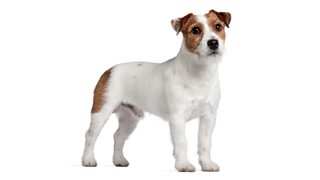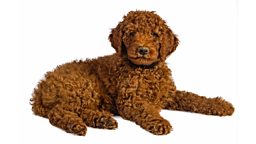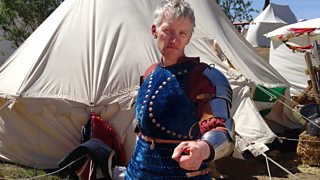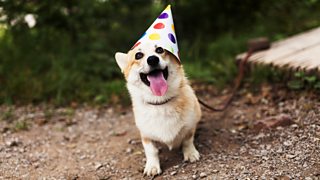How we got the dogs we know and love today
Anyone who has tuned in to will know that dog breeding is big business. But when did it start?
In Making History, presenters Tom Holland and Iszi Lawrence are joined by Ciara Farrell and Caroline Kisco from the Kennel Club Library to discuss the origins of dog fancying – the breeding and showing of pedigreed dogs – along with the beginnings of the breeds we know and love today. Why does the Jack Russell owe its existence to a milkman and a vicar? Who ‘invented’ the Doberman? And what was the sad fate of the Turnspit dog?

-
![]()
Making History
Bloodlines - from the Queenβs to man's best friend.
The Victorians saw pet culture take off
For millennia we’ve had dogs beside us as companions and as working animals, but around the beginning of the Victorian era there was a change in sensibility. People started seeing dogs as animals with agency, that should be treated in a moral way. Where before there had been mostly a working and sporting culture, where dogs were often cruelly treated, a new culture of keeping dogs as pets began to develop.
-
![]()
Natural Histories: Dog
Dogs have changed us and we have changed them.
The first βfancy showβ took place in a pub
Down in the local pub there was often a rat pit, where the clientele did betting sports with their fighting and ratting dogs. And it was here that men started to have “fancy shows”. The first one was held in Elephant and Castle in 1834. There were no breed classes – the winner was simply the man with the nicest dog.
Queen Victoria competed at Crufts
Dog fancying was a hobby that transcended class. From the working-class people who developed their ratting terriers as fancy pets, all the way up to the monarch herself. Queen Victoria even competed at in 1891 where her collie Darnley II and two of her Pomeranians won prizes.

Queen Victoria had dozens of different breeds
Queen Victoria had a bewildering variety of dogs. A little notebook containing a list of her pet dogs from 1846 tells us she had 28 different breeds. One of these was the German Boarhound – now known as the Great Dane.
The monarch’s dogs came from all corners of the British Isles and, in fact, all corners of the earth. Those who were out exploring and colonising were bringing dogs home as gifts for her majesty.

The Jack Russell owes its name to a sporting vicar
The Jack Russell has its roots in 1890.

The reverend John Russell, a great sporting parson, saw his milkman with a little dog called Trump. This mongrel – who was probably a bit of fox terrier and maybe a bit of black and tan terrier – was exactly what he was looking for in a sporting dog. She was small, which meant she could go down a hole to get a fox or badger.
Deciding this was the dog for him he developed what was known as the Parson Russell, John Russell or (as we know it today) the Jack Russell terrier.
The Doberman was bred to help collect taxes
At the end of the 19th century a German tax collector called Doberman (surprisingly enough) decided he needed a dog to accompany him when he was collecting funds. It wasn’t to frighten people into paying up (although it can’t have hurt) but to guard himself from thieves who might be after the currency he was carrying.
Using a number of different breeds – the Weimaraner, the Pinscher, and an element of German Shepherd – he produced a dog that was fearless but also looked pretty terrifying too.

The Turnspit dog died out with its job
There’s a breed that – although not fashionable or high-status – was ubiquitous in the kitchens of big houses in this country for centuries. It was called the Turnspit dog and it had possibly the worst canine job of all time.
This long-bodied, short-legged dog went into a little wheel that was mounted on the wall and ran in it like a hamster. This turned a chain, that turned the turnspit, that kept the meat roasting on the great fire.
It used to be that every kitchen had a little troop of these mutts but technology took over from the Turnspit dog and by the 18th century it was already in very low numbers. When the job finally disappeared, the dog died out.
How extensive is your dog’s vocabulary?

Can some clever pooches actually spell or tell the time?
The Labrador was first bred by Canadian fishermen
Who thought Labrador Retrievers came from Labrador in Canada? Well, you’d be wrong.

The breed actually originated in Newfoundland in the 1500s where fishermen bred them to jump into the icy lakes and haul fishing nets back to shore. This breed was known as the St. John’s Water Dog.
Then in the early 19th century the Earl of Malmesbury – who had seen these water dogs in action – brought some back to his English pad and trained them up to retrieve the ducks he shot when out hunting. Misinformed about their geographical origins he began to refer to them as his “Labrador dogs”. And the name stuck.
The first labradoodle was bred as a hypoallergenic guide dog
As far as dog breeds go, the Labradoodle is a veritable spring chicken. It was first bred in Australia in the late eighties when a man called Wally had the idea of combining the low-shedding coat of the Poodle with the gentle, hard-working qualities of the Labrador in order to create a guide dog suitable for those with allergies.
The first of these hypoallergenic guide dogs, Suntan, worked with a blind lady in Hawaii for ten years. These days the Labradoodle has taken the world by storm and is now one of the most popular crossbreed dogs on the planet, favoured by the Hollywood rich and famous.
Dog's dinner: why a third of us cook our own dog food

How do you know if your dog is getting the nutrition it needs?

More from Radio 4
-
![]()
Making History: Bloodlines
Bloodlines - from the Queenβs to man's best friend.
-
![]()
Eleven pawsome facts about dogs
Who's a good boy? We have the answer.
-
![]()
Maximus Waffles: How to give your pet a cool name
You've got a new puppy, but what on earth are you going to call it? Look no further.
-
![]()
The extraordinary world of premium pet food
The lengths that animal owners are going to to fuel their furry friends.





